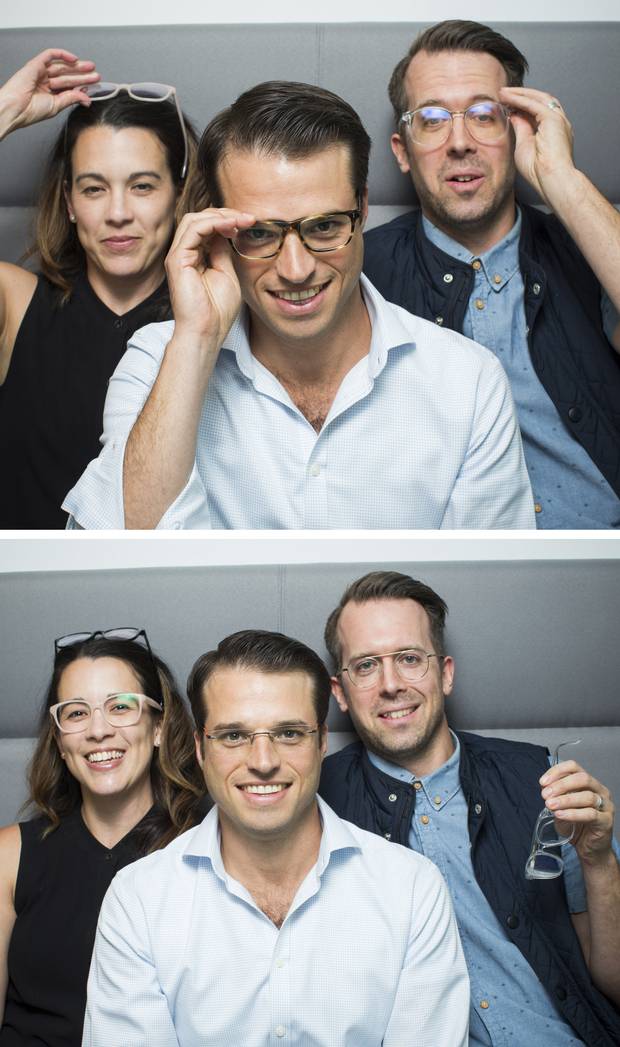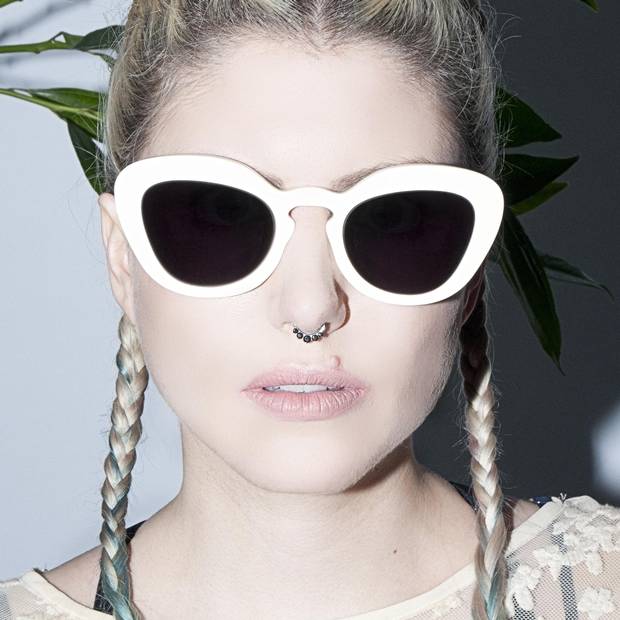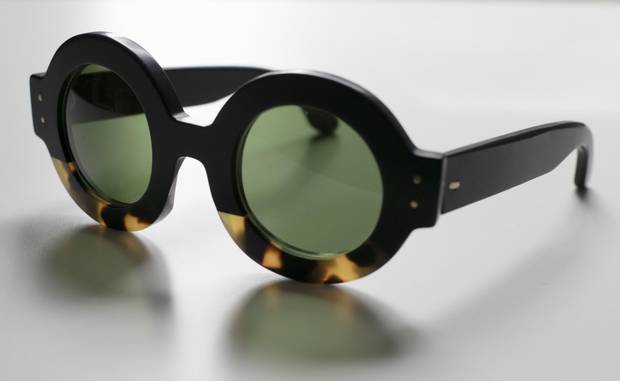
EYES ON THE PRIZE Clearly’s chief marketing officer Nancy Richardson (left), CEO Roy Hessel (centre) and senior creative director Nate McAnally (right) want to place more focus on glasses as a fashion accessory, rather than a necessity.
Ben Nelms for The Globe and Mail
Clearly, once known solely as an online destination for affordable contact lenses, has become one of the eyewear industry's major players. Sabrina Maddeaux travels with the brand to Milan and learns that the company is betting its future on fashionable frames
The MIDO Eyewear Show, which takes place every February in Milan, is the world's largest eyewear exhibition. Much like the high-end labels that show during the city's fashion week, optical brands go all-out to make an impression on MIDO's expo floor. This year, California's Oakley showed around a massive branded military truck, while Austria's Andy Wolf eyewear stocked its space with two surfer-boy DJs and free-flowing liquor. More than 1,000 exhibitors – from lens manufacturers to designer brands and idealistic startups – took up over 3.7 million square feet of exhibition space. There were six-foot-something leggy models at every turn sporting skinny jeans and designer frames.
In the midst of the bright lights and fanciful designs at the 2016 edition, Canada's Clearly stood out. Formerly known as Clearly Contacts, the Vancouver-based brand is now the world's largest online retailer of eyeglasses. While most Canadians recognize the company from its omnipresent online ads, it's aiming to be much more than a transactional destination for cheap glasses. Clearly is a major player in the $112-billion global eyewear industry, which sees e-commerce surging at a rate of 25 per cent every year, compared to the five-to-six per cent growth in online shopping overall. "Eyewear is at a transformation point," says Roy Hessel, Clearly's CEO. "Currently only 4 per cent of consumers buy their vision correction needs online. We want to convert the remaining 96 per cent."
To accomplish this, Clearly doesn't just want to transform the retail experience; it wants to revolutionize the product. "It's an industry in need of disruption," says chief marketing officer Nancy Richardson. "And I would love to be known as the brand that reinvents optical."
Clearly was launched in 2000 by Canadian entrepreneur Roger Hardy, who also owned the key words "contact lens" on the search engine Alta Vista. This meant that anyone who scoured the Internet for contact lenses saw Clearly's banner ads. Within its first month, the company had $68,000 in sales. As of 2013, Clearly had served over 5.3 million customers with sales of almost $60-million a year. It was sold to the French optical equipment company Essilor International in 2014 for $430-million and, as a private company, no longer publicly releases financial data, but says it has customers from Canada to Australia and everywhere in between.
In the beginning, it wasn't easy to convince shoppers to buy eyewear online without trying it on first. So to make customers feel more comfortable, Clearly put a huge emphasis on product education and creating technological substitutes for the in-store experience of shopping for frames. Today, those looking for a new pair of glasses can load a photo of their face into Clearly's system to virtually try on options. The company also offers personal consultations with "Vision Advisors" via phone or e-mail and produces a blog that breaks down everything from the design process to insurance advice.
"We aim to highlight and romanticize the product so it feels like you're actually holding the glasses in your hand instead of on your mobile phone," says Richardson. "Every interaction with us is aimed at building trust." Clearly also offers free returns and has three brick-and-mortar stores in Toronto and Vancouver.
Clearly isn't the only company targeting glasses-wearers with these sales methods. New York City-based Warby Parker and California's Zenni Optical are two of the company's main competitors. Warby Parker made Fortune's "unicorn" list of startups valued at over $1-billion (U.S.) in 2015 and Zenni Optical offers some of the cheapest eyewear in the business, with prices starting at just $6.95 (U.S.). Warby Parker also has brick-and-mortar locations, while Zenni has kept costs low by investing in its own 248,000-square-foot manufacturing facility in China. To add an extra personal touch in a sometimes impersonal online word, Zenni allows its customers to add custom text to the arms on frames. Clearly claims its sales continue to outpace both Warby Parker and Zenni.
Clearly's next grand plan is to become a design powerhouse. The new fashion focus is part of why Clearly changed its name from the transactional-sounding ClearlyContacts.ca in May 2015. While Clearly sells third-party lines like Calvin Klein and Hugo Boss, it has 10 in-house brands, including the retro Joseph Marc, geek-chic Derek Cardigan and fashion-focused Kam Dhillon. Their frames have been spotted on the likes of Taylor Swift and Ty Burrell.
Claire Foster, accessories director at global trend forecaster WGSN, says Clearly's focus on in-house designs is an important competitive advantage in the vast eyewear industry. "Customers are far more likely to be loyal to eyewear brands once they find one that works for them," she says. "So, especially when it comes to e-commerce, defining a brand and having in-house signature details is important to help build trust and recognition with consumers."
Designing a great pair of glasses isn't as easy as simply choosing shape and colour. Clearly's two-person design team spends a lot of time tinkering with the ergonomics of matching frames to faces. It can take between six months to a year for a design concept to go live, and what looks great on screen doesn't necessary translate well to the human face. They begin by sketching silhouettes and selecting elements such as hinges, screws and acetates. Several weeks later, the team receives a prototype of the frames for quality testing and trials before the final product run is made.
Clearly launches new collections of at least a dozen frames for each of its 10 in-house brands annually. That number will grow as Clearly aims to launch up to five other house labels in the next two years. While its own brands don't outsell third-party styles yet, Richardson reports they are outpacing them in terms of growth.
Over the course of a weekend at MIDO, the Clearly team met with various manufacturers and suppliers to discuss how they can push the design envelope. There was talk of colours, prints and frame shapes, but also a lot of time spent on details few consumers think about. Should frames be cut out of acetate or injection-moulded? Can spring hinges be more low profile? What sort of wires should go in the frames? These small parts all affect the look, feel and quality of a pair of glasses. "In eyewear, a tenth of a millimeter makes a huge difference," says senior creative director Nate McAnally, who was previously the creative director at Lululemon.
For Richardson and McAnally, the show was a chance to better learn about what other companies are offering, build relationships and see how the back end of the business functions. "I've never seen anything like MIDO," says Richardson. "What really stood out to me is how much art and design there is in the eyewear world. It's endless. It makes me realize we're just at the tip of the iceberg."
According to a recent study published in the Journal of Ophthalmology, half the world's population – nearly five billion people – will be shortsighted by 2050. This gives companies like Clearly, Warby Parker and Zenni Optical plenty of room to grow over the next few decades. The key to tapping into that potential will be making eyeglasses fashionable rather than utilitarian. Clearly's goal is to forge a connection between customers and their eyewear – the way people feel about their favourite pair of heels or designer bag. They figure if fashionistas have closets full of stilettos, why not drawers full of glasses?
Sabrina Maddeaux travelled to Milan as a guest of Clearly. The company did not approve or review this article prior to publication.

Guild Eyewear’s vintage-inspired MJ frames are just one of the bold sunwear options from Canada’s growing crop of optical brands.
From a Toronto line with African roots to an East Coast label crafting frames for a New York design legend, Odessa Paloma Parker highlights Canada's brightest glasses lines

TECH DRIVEN
"Many people can't find glasses that fit, much less glasses that fit and look good. So they settle for something uncomfortable, or that they don't like, or they tell themselves it doesn't matter," says
Rod Frey, founder of Toronto-based brand Guild Eyewear. "The core belief that the company started with was that a product could be customized and made in single quantities using modern automation technology and smart software." Frey's background as a technologist lead him to develop and build the software and CNC machinery used to create Guild's line of quirky, hypoallergenic frames, which are produced using organic materials. Driven as much by attention to novel design as craftsmanship, Guild has collaborated with creatives such as fashion brand Untitled & Co, and industrial designers Angelika Seeschaaf and Katherine Tessier. The frames made with Tessier were displayed during Toronto's Offsite Design Festival this past January as part of the MADE Primary exhibition and won a Juror's Choice award. For more information, visit www.guildeyewear.com.

WORLDLY VIEW
For Nana Boateng Osei, the sustainable, economic and philanthropic goals of his eyewear line, Bôhten, are personal. Osei's Ghanaian heritage led the Carlton University graduate to pursue a connection between that country and his home in Canada by using reclaimed wood from Africa for the line's chic frames. "I loved the culture of entrepreneurship in Toronto," he says of an early visit to the city, where Bôhten opened its first factory last year. The brand also has a production facility in Ghana, and Osei is now setting his sights on opening another factory there by 2017. He sees great opportunity in the still tumultuous country. "We can't change Africa, and we can't change Ghana. All we can really do is lead by example," he says. Osei also wants to give back to others in the community; Bôhten has teamed up with British charity Sightsavers to donate $5 from each purchase toward eye care and blindness prevention in developing countries. For more information, visit www.bohten.com.

CRAFT SERVICES
"I couldn't find the exact kind of cat-eye [frame] I was looking for, and I thought, 'Maybe I'll just make it.' So I made three of them and put them out and they sold out that week," says Mosh Designs's Sara Moshurchak, who is also an optician and the owner of Vancouver retailer Eyeland Framemakers. What started as a quest for her own personalized glamorous silhouette has turned into a full-fledged handmade eyewear business. "You can have a really nice suit, but if it's not tailored well, it's not going to look good," Moshurchak says, explaining her brand's attention to fit. Frames can take anywhere from four weeks for a modification on an existing design to three or four months for an entirely bespoke pair. In a world where you can pop into almost any retailer to purchase sunglasses, how do Moshurchak's customers feel about the deeply personal attention paid to their shades? "It's a little overwhelming when you tell people they can do whatever they want." For more information, visit www.eyelandframemakers.com.

RUNWAY READY
For Sydney and Chris Seggie, starting their eyewear business Fellow Earthlings in Prince Edward Island was a natural fit. "We wouldn't exist if it wasn't for the island and its history of eyewear production," Sydney says. "The vintage Ray-Ban's that are so coveted today were made here in the eighties." Though the scale of manufacturing on P.E.I. has significantly diminished, its fashion-forward legacy is alive and well in Fellow Earthling's contemporary sunglasses selection. The brand has also collaborated with other Canadian lines including Tuck Shop Trading Co., as well as Anna Sui, one of New York's most beloved fashion designers. "We have had the incredible opportunity to make the sample sets for her shows for many seasons," Sydney notes. Having launched Fellow Earthling's e-comm business in 2014, the Seggies are helping lead the shop local movement. "We want to make the decision to buy Canadian easy, not only because it's handmade in Canada, but because it's high quality and great value." For more information, visit www.fellowearthlings.com.